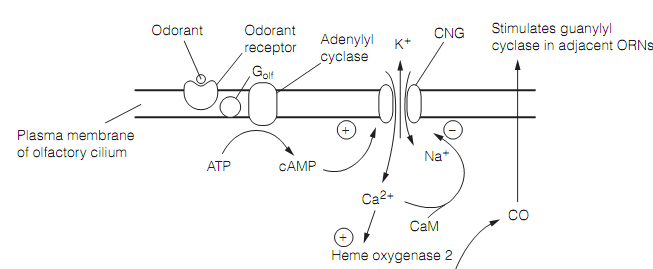Olfactory transduction
Odor molecules are generally small (Mr < 200 Da), volatile, and lipid soluble. Originally they bind to odor-binding proteins in the mucus that concentrate the odor molecules in the vicinity of the cilia. Odor molecules are acknowledged by odorant receptors in the cilia plasma membrane. These are G-protein-coupled receptors, around 1000 have been specified in mammals. A given odor molecule can bind 2-6 various odorant receptors. Odorant receptors are relatively non-specific, binding a range of associated odor molecules, therefore though an individual ORN expresses merely a single subtype of odorant receptor it responds to numerous odors. The mammalian nervous system is capable to discriminate few 10 000 distinct odors on the basis of accurately that array of odorant receptors (and therefore sensory neurons) are stimulated, and by what relative intensities.
Odorant receptors are coupled to Golf proteins (associated to Gs proteins) that generally stimulate adenylyl cyclase, and binding of an odor molecule causes a increase in cAMP in around 50 ms. This activates a cyclic-nucleotide-gated (CNG) channel, a non-specific cation conductance permeable to Na+, K+, and Ca2+ ions as shown in figure below. The resultant depolarizing generator potential is graded with amplitude which signals the concentration of the odor molecule. Though, maximal response is generated by the opening of only a small fraction (3–4%) of the CNG channels available. This means that the concentration variety which can be signaled by firing of an ORN is narrow, around a 10-fold difference.

Figure: Olfactory transduction in olfactory receptor neurons mediated by receptors coupled to the cAMP second messenger system. Here CaM=calmodulin; CNG=cyclic-nucleotide-gated channel.
High odor concentration or prolonged exposure permits a high Ca2+ influx via the CNG channels. The ion has a number of modulatory effects in olfactory receptor neurons. The Ca2+ activates heme oxygenase 2, an enzyme which synthesizes carbon monoxide (CO) that can activate guanylyl cyclase (GC) which is as shown in figure. As Ca2+ also reserves GC, there is no overall activation of the cyclase in the target ORN. Thiugh, CO is freely diffusible therefore it can activate GC in adjacent unstimulated ORNs, generating cyclic guanosine monophosphate (cGMP) that binds to and opens the CNG channels. In this manner odorant excitation spreads to a cluster of ORNs. As neighboring ORNs respond to the similar odors this increases sensitivity without loss of specificity.
ORNs illustrate adaptation to protracted stimulation. Ca2+ binds to calmodulin (CaM) that can then bind to CNG channels, decreasing the efficacy with which the cyclic nucleotides can open them. Therefore Ca2+ attenuates the size of the generator potential.